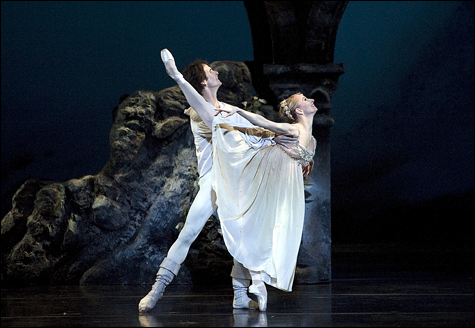
NOT A MATCH MADE IN HEAVEN: but Larissa Ponomarenko and Nelson Madrigal did create a long
emotional line. |
Romeo & Juliet | Music by Sergei Prokofiev | Choreography by John Cranko | Staging by Jane Bourne | Sets and costumes by Susan Benson | Lighting by Christopher Dennis | With the Boston Ballet Orchestra conducted by Jonathan MCphee | Presented by Boston Ballet at the Wang Theatre; Remaining performances February 28–March 2
Future Romeos & Juliets
Nelson Madrigal & Larissa Ponomarenko | February 28, March 1 afternoon
Carlos Molina & Lorna Feijóo | February 29, March 2
Jaime Diaz & Erica Cornejo | March 1 evening |
Boston Ballet has been playing the Romeo and Juliet dating game for almost 25 years now. Bachelor #1 was the version that Choo San Goh created for the company in 1984, its events orchestrated by Fate in a gray unitard. They went out together again in 1986, 1989, and 1993, but the question never got popped. By 1997, the company had moved on to Bachelor #2, a commission from then-resident-choreographer Daniel Pelzig that was short on choreography but long on characterization. No second date for Danny, or for Bachelor #3, the Rudi van Dantzig Romeo that got staged in 2003, class warfare superseding romance. Bachelor #4? Well, Boston Ballet has had long-term relationships with John Cranko’s Onegin (1994, 1997, 2002) and The Taming of the Shrew (1995, 2004), so why not his Romeo & Juliet? They had their first date on Valentine’s Day, and though Cranko won’t ever be mistaken for Petipa or Balanchine (on the occasion of the New York visit of his Stuttgart Ballet in 1969, Arlene Croce made reference to the “gaseous, depleted, bottom-of-the-bill ballets by bottom-dog choreographer Cranko”), his Romeo, measured and weighted like Shakespeare’s original, does suit the company.Boston Ballet’s press material makes the curious statement that “Cranko’s Romeo & Juliet is widely regarded as the pre-eminent version of this enduring ballet.” Of the many versions set to Sergei Prokofiev’s 1935 score (and the few to music by Berlioz, Tchaikovsky, and Delius), the one most balletgoers are familiar with is Kenneth MacMillan’s, in large part because in 1966, just a year after its debut, it was immortalized on screen by Rudolf Nureyev and Margot Fonteyn. You can watch that and other performances of the MacMillan on DVD, as well as versions by Leonid Lavrovsky and Nureyev himself — but not the Cranko.

Which is not to say that MacMillan’s is the pre-eminent version of Romeo and Juliet. He drew from Cranko, and they both drew from Lavrovsky, who did the original Russian version for the Kirov in 1940. Cranko made his first Romeo in 1958, for La Scala, with Carla Fracci as Juliet; in 1962 he remade it for his own Stuttgart Ballet, with Marcia Haydée as Juliet. No surprise that when in 2004 Ballet.co asked Alessandra Ferri — who danced Juliet for both Cranko and MacMillan — to talk about the difference between the two, she didn’t have much to offer. Cranko’s is the more muted, the more natural; it has a circular, communal, folk-dance feel. MacMillan’s is more theatrical, more Broadway, with its insistent diagonals (underlining the Renaissance rediscovery of perspective) and repressive patriarchy and red-headed league of whores (as against Cranko’s good-time Gypsies) and cock-of-the-walk spotlight dancelets directed at the audience. (Nureyev was cockier still, particularly in his own appearances as Romeo.) Many moments in Cranko’s ballet are echoed in MacMillan’s: Juliet cupping her burgeoning breasts (that one came from Lavrovsky); Tybalt’s despairing leap at Romeo after being run through; the way Juliet cradles Romeo after discovering his body.
Susan Benson’s set design is built on a massive stone arcade that rises in the middle to form a bridge, giving the ballet two playing levels. It’s the backdrop for the market scenes and also serves as Juliet’s balcony (with a stone outcropping for Romeo to climb up rather than stairs for her to scamper down). Affix a huge lion’s head with sunburst mane to the bridge and you have the Capulet ballroom; let down two streaming white curtains from the ceiling to frame Juliet’s bed like angel wings and you have her boudoir. (Both these indoor scenes are open to the sky — of course, in Shakespeare’s theaters, everything was open to the sky.) For the final scene in the Capulet crypt, Juliet’s body is carried to the top of the arcade bridge and let down through an opening to her resting place below, which is in the exact same spot her bed was. The arcade does confine the dancers, especially in the balcony pas de deux; you might well miss Alain Vaës’s set for the Goh and Pelzig productions, with its half-hidden equestrian statue in the piazza. The pre-ball scene where Lady Capulet gives Juliet her party dress and the two scenes in church with Friar Lawrence are played in front of monochromatic scrims that pale behind Benson’s opulent costumes: mostly beige and blue for the Montagues, red and black for the Capulets, white for Romeo and Paris, pink dominos outside the Capulet palazzo, tones of red and orange and gold and cream and black inside, a riot of orange and brown and green in the marketplace. Christopher Dennis’s atmospheric lighting is misty for Verona at dawn, torch-lit for the Capulet ball.